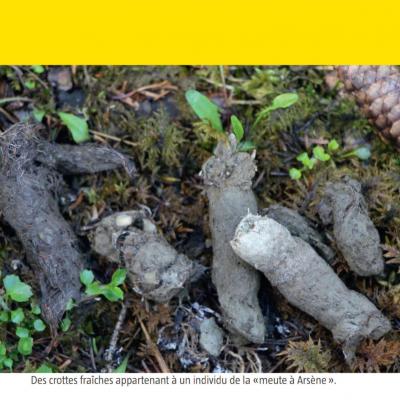
This is the kind of tracking where everything starts well. After a few hundred meters on the trail, which climbs gently between white fir trees in Val d'Hérens, Valais, two morels emerge from the moss. Nothing to do with wolves, but possibly a good omen for mid-June. Bingo! Barely enough time to resume walking when, right there in the middle of the path, fresh canine droppings. Always a magical moment. We imagine him lurking in the woods, watching us. Conjecture is rife about the freshness of the droppings. Unfortunately, we don't know yet, but our luck has already changed. The two nearby camera traps only show images of squirrels, chamois or foxes. There will be no further clues from the forest today.

A pack cut in half
We are in the heart of the home range of the “Arsene's pack”, whose individuals have been studied for two years as part of the Wolf Mission project. Led by Isabelle Germanier, director of the Groupe Loup Suisse in French-speaking Switzerland, and biologist/ethologist Virginie Nierat, this study is intended to provide a better understanding of the predator's behavior in our country, to facilitate cohabitation with livestock farming, and to raise public awareness of the life of a pack. “This project has been on my mind for quite some time, as there are very few field studies on this apex predator in Switzerland. We often rely on American or European studies", notes Isabelle Germanier.
The major difficulty for the team was that the pack studied had suffered the full force of the proactive regulation phase, which resulted in the death of 46 wolves in Switzerland, including 27 in Valais, between December 1, 2023 and January 31, 2024. “Last year, before the regulation shots were fired, the pack included the breeding pair, a subadult female from the previous year and at least 5 cubs. A former subadult, M397 came back with the pack just before the shooting began, this decision cost him his life. After the shootings, we were left with 4 individuals: the breeding female, two cubs from 2023 and another subadult”, note Isabelle & Virginie.
Particularly targeted for damage to livestock in 2021 and 2022 - between 50 and 60 animals were killed (even if only 14 victims died in 2023, of which only 5 were protected), the Arsene's pack came very close to disappearing. It's also been a difficult time for the team. “There was a lot of anger: individuals were shot indiscriminately without knowing who they were or which pack they belonged to. With a scientific consensus, it could have been done differently, targeting packs or wolves causing damage”, sighs Virginie Nierat. “What people don't always understand is that by following a pack, you recognize the individuals”, adds her colleague. “Each pack functions differently. We've observed that an injury can condition how they hunt, where they move. What's a pity with proactive regulation is the lack of a scientific goal. We should have taken samples from two livestock-killing packs (editor's note: Nanz & Augstbord) and seen how these families behave in terms of attacks afterwards”.
Shooting to resume in early September 2024
Since the spring, the Wolf Mission team - some 50 people in all - has been replacing camera traps and collecting clues in the field. Isabelle Germanier hopes to meet the carnivores in the flesh again, as she did when she captured a night hunt in autumn 2023. “The young female came out of the edge of the larch forest, here above me", she points out in a valley at 2000m altitude, above which still lies a good layer of snow. “The she-wolf was upwind and started chasing a herd of deer. They started to flee, before a large stag turned and confronted the predator. They judged each other, then the she-wolf turned back, passing 12m away from me".
The Wolf Mission team may never witness such a scene again. A new phase of proactive regulation began on September 1. “If the shootings continue, we are aware, given the relentlessness with which this pack has been treated (editor's note: last winter and this year, to obtain its shooting), that it runs the risk of disappearing”. But all is not over yet. Until July 5, 2024, the Federal Council had opened a consultation period on Parliament's revision of the Ordinance on Hunting (OChP), which allows wolves to be shot before they have caused any damage. In its own way, Wolf Mission hopes to influence the debate by rehabilitating the predator in order to restrict shooting to problematic individuals.
Wolf Mission clarification: as the interview was conducted in June 2024, some facts have been modified to reflect current events, so that readers can obtain certified, up-to-date information. We would also like to point out that an error crept into the original paper article, which we have corrected in the present article. In fact, only Ms Virginie Nierat is a biologist. We also confirm that Arsene, the breeding male, was shot on January 13, 2024.
This year, the pack has not reproduced, despite contradictory statements by the authorities. The pack is currently being targeted by regulation shots, having killed only 3 sheep in 2024, 2 of which were in a protected situation. Of the two wolves shot in November 2024, at least one does not belong to the Hérens/Mandelon (Arsene's) pack, based on fieldwork and available data.
We would like to pay tribute to Arsene, who was the first individual we were able to see and who managed to hold his pack together despite a delicate situation. He will always remain in our minds and memories.
Article: La Salamandre Magazine - Camille Belsoeur
Photos: La Salamandre Magazine





